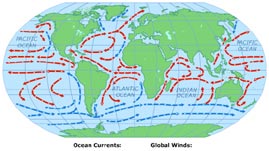Teachers' Domain - Digital Media for the Classroom and Professional Development
User: Preview

Source: McDougal Littell, a division of Houghton Mifflin Company. Developed by TERC, Inc., Cambridge, Massachusetts
When most people think about the movement of ocean water, they think of waves or tides. Less visible are ocean surface currents that can move water as much as 100 kilometers (62 miles) per day and distribute everything they contain to distant oceans and seas. This visualization from McDougal Littell/TERC illustrates the patterns of ocean currents and the global wind patterns that drive them.
Messages from environmental organizations regularly remind us of the importance of recycling: throwing garbage away is not only wasteful, but offers no real solution. Placing refuse into an outdoor dumpster may remove garbage from your home, but the garbage has to go somewhere, and — depending on where you live — it probably finds its way to a landfill. However, for many communities around the world, the ocean serves as a dumping ground not only for trash, but also for tons of untreated sewage and industrial and nuclear waste.
The problem with this type of waste removal is that some materials dumped or pumped into the ocean are carried by ocean surface currents to shores thousands of kilometers away. Medical waste tossed into the North Atlantic has washed up onto Virginia beaches weeks later. Nuclear waste, which persists in the ocean for decades, has contaminated oceans far from the power plants where it originated. And, in a less macabre example, bathtub toys accidentally dumped from a cargo ship in the middle of the Pacific Ocean in 1992 eventually washed ashore on the United States' Atlantic coast more than 11 years later.
Of course, ocean currents are not significant only for their role in distributing pollutants. They also transport nutrients that sustain vital fisheries, and they carry heat from the tropics toward the poles, making northern latitudes more habitable.
Ocean currents move in response to global winds, which form three separate bands in each of the northern and southern hemispheres. Closest to the equator are the trade winds. These winds blow from east to west and create ocean currents that move in that direction. In the mid-latitudes, the prevailing westerlies blow in the opposite direction and push ocean currents eastward. The polar easterlies are closest to the poles and blow from east to west, driving currents westward.
Because continents impede their flow, ocean currents don't mirror the orderly patterns of global winds. As a result, they form cyclical patterns, called gyres, around the perimeter of Earth's oceans and seas. Gyres in the northern hemisphere move in a clockwise direction and those in the southern hemisphere move in a counterclockwise direction. These gyres also connect to a vast network of other currents, which explains how pollutants dumped in the middle of an ocean on the other side of the world might one day find their way to a beach near you.
 Loading Standards
Loading Standards Teachers' Domain is proud to be a Pathways portal to the National Science Digital Library.
Teachers' Domain is proud to be a Pathways portal to the National Science Digital Library.
